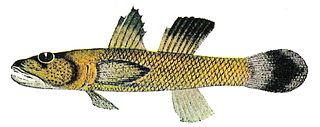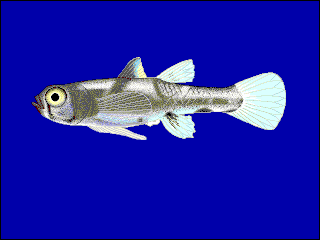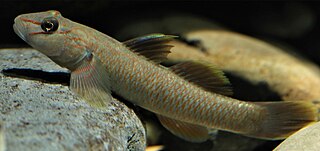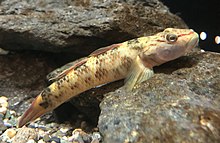Gillichthys is a genus of gobies native to the coasts of Baja California and southern California.
Odontamblyopus rebecca is a species of eel goby native to marine and brackish waters of Vietnam. This species can reach a length of 14.1 centimetres (5.6 in) SL. This species is mostly known from several specimens collected from a fish market in Haiphong, Vietnam.
Lentipes whittenorum is a species of goby endemic to marine, brackish and fresh waters of Indonesia. The specific name jointly honours the biologists Anthony (Tony) and Jane Whitten, who assisted the describer Kottelat in a number projects in Indonesia, particularly in the survey of Bali, an island on which this goby occurs.
Mugilogobius sarasinorum, Sarasin's goby, is a species of goby endemic to Lake Poso in Sulawesi, Indonesia. This species can reach a length of 8 centimetres (3.1 in) TL. It is important to local commercial fisheries and the fishing community.

The ice goby is a species of goby in the subfamily, Gobionellinae, and the only member of the monotypic genus Leucopsarion. It is native to the northwestern Pacific Ocean, where it occurs in China, Japan, and Korea. Its English language common name is ice goby, and in Japanese it is known as shiro-uo. In Japan, where it is a delicacy, it is also called shirauo no odorigui.

Rhinogobius carpenteri is a freshwater species of goby endemic to the Philippines. Its common name in the Philippines is kuchu. The species was named for the co-collector of the cotypes, Mr. W. D. Carpenter. In 1927, Albert William Christian Theodore Herre erected a new genus in the family Gobiidae, Tukugobius and moved R. carpenteri into it as the type species, but the genus was later rendered invalid.
Gerald Robert "Gerry" Allen is an American-born Australian ichthyologist. His career began in 1963, when he spent a semester at the University of Hawaii, where he also received a PhD in marine zoology in 1971. In 1972, Allen wrote his doctoral thesis on the systematics and biology of the anemone fish.
Akihito is a genus of gobies native to streams in Vanuatu.
Eutaeniichthys gilli is a species of goby native to brackish waters of the northwestern Pacific Ocean from around Japan, the Korean Peninsula and the Yellow Sea. It is an inhabitant of estuarine tide pools where it can be found under rocks. This species grows to a length of 4 centimetres (1.6 in) SL. This species is the only known member of its genus. The generic name is a compound of eu meaning "good", taenia meaning "ribbon" or "tape", Eutaenia being a synonym of the garter snake genus Thamnophis, and ichthys, "fish". The specific name honours the American ichthyologist Theodore Gill (1837-1914) for his work on the gobies of Japan.

Sicydium plumieri is a freshwater species of the goby native to the Antilles from Cuba to Trinidad and Tobago, though not recorded from all islands. This species can reach a length of 11 centimetres (4.3 in) TL. It is also known by the English common names sirajo, Plumier's stone-biting goby, and tri-tri goby. The young, which are regarded as a delicacy, are of commercial importance. The specific name honours Charles Plumier (1646-1704), a Franciscan friar and naturalist, who found the first specimens of the species on Martinique and Marcus Elieser Bloch based his species description on Plumier's drawings.

Pandaka is a genus of fish in the goby subfamily, Gobionellinae, native to fresh, brackish and marine waters of Asia and the western Pacific Ocean. Some species in the genus are among the smallest fish in the world; the male P. pygmaea can be just 9 mm (0.35 in) in standard length at maturity.
Mugilogobius chulae, commonly known as the yellowstripe goby or Chulae's goby, is a species of freshwater, brackish goby, where it feeds on small crustaceans, aquatic insects and insect larvae. It is found in coastal eastern Asia from the Ryukyu Islands south to Sumatra.
Pandaka lidwilli, or the Lidwill's dwarf goby, is a species of goby found in brackish and salt water in the mouths of rivers and maritime zones in Japan, Australia, and Papua New Guinea. The specific name honours the Australian anesthesiologist and cardiologist Mark C. Lidwill (1878–1969), who was co-inventor of the pacemaker, as well as being a saltwater angler who, while fishing for game fish, observed this tiny goby and brought it to the attention of Allan Riverstone McCulloch who subsequently described it.
Mugilogobius wilsoni, commonly known as Wilson's mangrove goby, is a species of goby native to the waters of northern Australia.

Rhinogobius zhoui, known as Zhou's scarlet goby in the aquarium trade, is a species of freshwater goby from the subfamily Gobionellinae which was discovered in a stream on Lianhua Mountain in Haifeng County, Guangdong Province, China. This goby also native in the other part of Guangdong Province and Guangxi Province, for some similar described species,which are called Resemble Zhou's Rhinogobius (类周氏吻虾虎) and New Red Rhinogobius (新红吻虾虎) in China, are found in streams of those places.
Biendongella is a genus of fish in the subfamily Gobionellinae native to the South China Sea. The generic name is formed by adding the diminutive suffix ella to the Vietnamese name for the South China Sea, Bien Dong.
Pseudogobiopsis lumbantobing is a species of goby from the subfamily Gobionellinae which is found in Java and Sumatra where it occurs in freshwater rivers and streams at altitudes of 5–22 metres (16–72 ft), with substrates made up of sand, gravel, rock, and boulders and where there may be growths of algae and aquatic macrophytes. This species has been traded in the European aquarium trade since 2001.
Helen K. Larson is an ichthyologist who specialises in the fishes of the Indo-Pacific.
Stiphodon larson is a species of goby found in Papua New Guinea. This species can reach a length of 3.1 centimetres (1.2 in) SL.

Rhinogobius candidianus is a species of freshwater goby. It is endemic to Taiwan.






